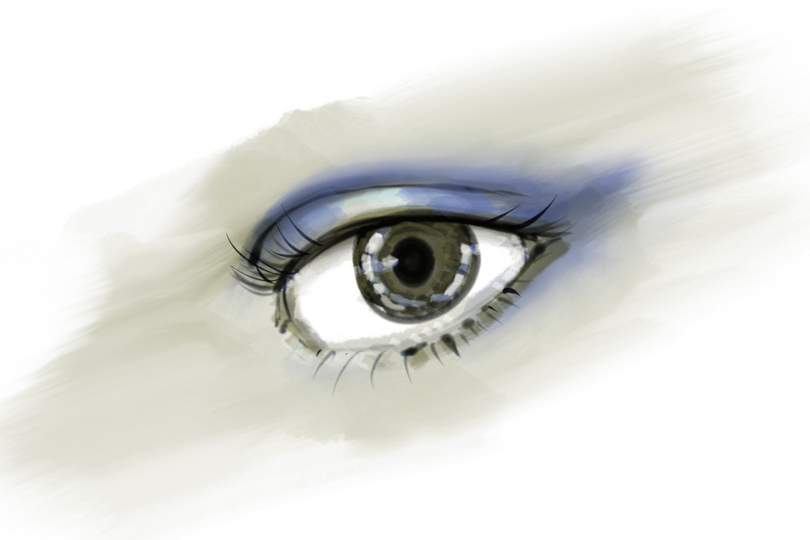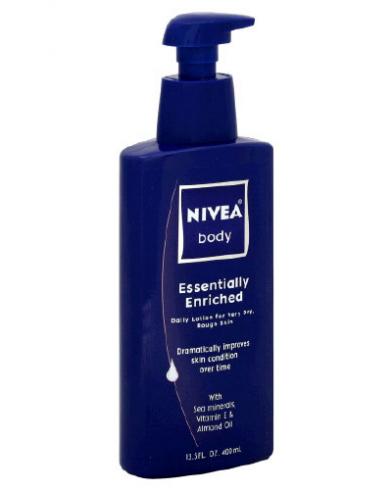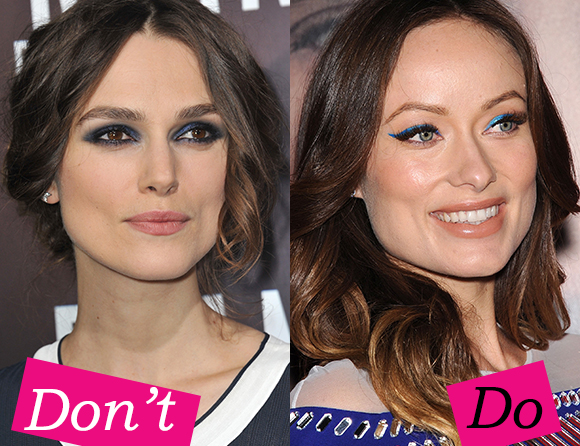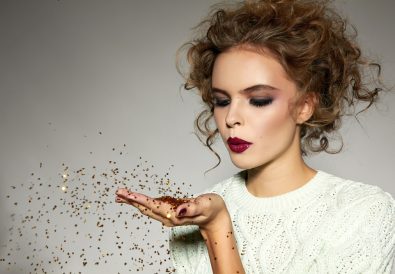Part of an ongoing series of 29Secrets stories, taking a deep dive into the history of legendary beauty products and iconic fashion moments…
By Christopher Turner
Illustration by Michael Hak
Did you know that the earliest use of eyeshadow can be traced back to 10,000 BCE, approximately 12,000 years ago? It’s true: this beauty staple has a rich history that spans thousands of years and a variety of cultures. Over the years eyeshadow has been offered in an endless variety of textures, compositions and colours to help change the wearer’s appearance with just a swipe, and it has instantly defined eras and icons…think dark, smoky eyes from the 1920s or intense blue eyeshadow from the 1980s.
No matter the decade, though, eyeshadow has always helped add depth and dimension to one’s eyes, complemented one’s eye colour, helped make one’s eyes appear larger, or simply helped draw attention to the eyes. That’s probably why it’s been used by women, and some men, for thousands of years.
There’s evidence of people using eye makeup as far back as 10,000 BCE, but the earliest direct archeological evidence dates back to predynastic Egypt (c. 5000–4000 BCE). Traces of eye paints, most commonly malachite (a green mineral) and galena (a black mineral that’s a form of lead sulfide), as well as cosmetic palettes, pots and applicators have been found in burials from this period.
Of course, eyeshadow has evolved significantly since, reflecting changes in societal norms, fashion trends and technological advancements. We’ve already covered off the ancient origins of eyeliner in a previous edition of The Story Of, so let’s dive into the fascinating history of eyeshadow, eyeliner’s best ally to enhance the eyes.
Ancient beginnings
As early as 10,000 BCE, Egyptians and Mesopotamians made use of various cosmetic products, primarily for aesthetic reasons. The first recorded substance known to historians that was used to highlight the eyes is kohl, which was used by the people of ancient Egypt to trace their eyes and was applied with a thin stick or needle. Kohl is a mixture of galena and other minerals mixed with water, oil or other soluble substances, like animal fat. Poorer Egyptians had to replace lead and other minerals with fire soot, meaning that the quality of one’s kohl (detectable by its shine and wear) could be used as a measure of class. Though its formulas have differed slightly based on time, location and the wealth of its wearers, the function of kohl remained the same: to decorate the eyes, brows, and occasionally other facial features. Both men and women wore kohl, demonstrating its cultural significance.
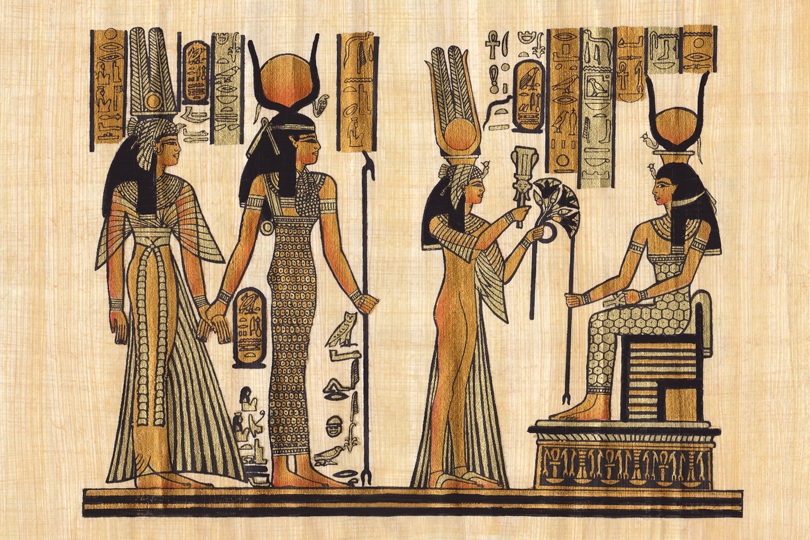
Darkening the eyelids with smudged kohl wasn’t solely for aesthetic purposes, though; kohl had practical uses as well in ancient Egypt. Historians believe that the oils and animal fats used to make kohl helped protect the eyes from the harsh sun. Historians also believe that Egyptians wore kohl to honour deities and to ward off evil spirits. Newer research theorizes that ancient eyeshadow was worn by both sexes and all social classes to help prevent eye infections, which were especially problematic in marshy environments such as the Nile area. In 2010, scientists discovered kohl’s antibacterial properties and, after studying samples of ancient Egyptian eyeliner held in 52 different containers in the Louvre museum in Paris, they reported that the eyeliner actually did help the immune system of these early beauty pioneers by helping to prevent and fight bacterial infections.
Of course, the use of kohl wasn’t exclusive to ancient Egypt. Along with other cosmetics and exotic goods, it was exported from Egypt and sold across the Mediterranean during ancient times. Historians have found evidence of the use of kohl and other substances used to magnify the eye by, among others, the ancient Romans, the Canaanites in the Levant, the ancient Greeks, and others.
Mesopotamia and classical antiquity
Traces of ancient eyeshadow have been found from around five thousand years ago in Mesopotamia (present-day Iraq), where people used crushed gemstones and other natural pigments to decorate the lids of their eyes. Lapis lazuli, a deep blue stone, was particularly prized for its vibrant colour. The use of eyeshadow in Mesopotamia, much like in Egypt, was both decorative and symbolic, often associated with status and religious practices.
In ancient Greece and Rome, the use of eyeshadow became more refined, and abandoned any religious significance it had had in Egypt and Mesopotamia. In both Greece and the Roman Empire, eyeshadow was initially used by the aristocracy of the time and seen as a sign of status. Greek women used a powder called “stimmi,” made from lead-based materials, to enhance their eyes, while the Romans adopted this practice, using a similar substance called “fucus.”
Greece imported much of their eyeshadow (as well as other fine makeup products) from India and Mesopotamia, while the Romans created their own version, mixing herbs, spices, minerals, dried flowers and parts of animals. Of course, it goes without saying that many of these early forms of eyeshadow were not as safe as modern products, as they often contained harmful, even deadly, ingredients.
The Middle Ages to the Renaissance
During the Middle Ages, the use of cosmetics, including eyeshadow, declined in Europe because of the influence of the Church, which viewed makeup as vanity and morally questionable. In fact, makeup is mentioned in the Bible, in both Jewish and Christian scriptures. The Book of Jeremiah, which details the titular prophet’s ministry from about 627 BCE to 586 BCE, argues against cosmetics use, thereby discouraging vanity: “And you, O desolate one, what do you mean that you dress in crimson, that you deck yourself with ornaments of gold, that you enlarge your eyes with paint? In vain you beautify yourself. Your lovers despise you; they seek your life.”
However, in the Islamic world, the tradition of using kohl continued, maintaining its cultural and medicinal significance.
The Renaissance saw a revival of cosmetics use in Europe. Influenced by the rediscovery of classical ideals of beauty, women began to use makeup more frequently. Eyeshadow, often made from natural substances like burnt almonds, was used to create a dramatic look, complementing the elaborate fashions of the time.
The 18th and 19th centuries
In the 18th century, beauty standards in Europe were heavily influenced by the lavish lifestyles of the aristocracy, which led to elaborate hairstyles, powdered wigs, porcelain-like skin, and a surge in the popularity of cosmetics. During this time period, eyeshadow was used to create the pale, delicate look that was fashionable at the time. However, the use of eyeshadow was still limited compared to other cosmetics such as face powder and rouge.
The advent of the Industrial Revolution (generally considered to span from about 1760 to 1840), and the transition to creating goods by machine rather than by hand, brought about significant changes in the world of makeup. Improved manufacturing techniques made cosmetics more accessible to the general public. However, eyeshadow remained relatively understated compared to other beauty products.
The 19th century embraced all forms of physical beauty, while men and women frequently used hair dye, skin lighteners (which, as they contained powdered lead and other harmful products, often proved toxic) and all types of cosmetics, including eyeshadow. Makeup was completely in vogue until the Victorian era, when Queen Victoria reigned over the English Empire from 1837 until her death in 1901. During this time period there was another widespread movement against cosmetics after Victoria declared makeup to be vulgar, and cosmetics once again went out of fashion. Though many women didn’t give up makeup entirely, many now applied it in secret: who was to say their cheeks weren’t naturally rosy?
A revolution in makeup
The early 20th century marked the beginning of the modern cosmetics industry as we know it now. In the 1920s, the flapper movement popularized bold makeup, including dark eyeshadow and smoky eyes, while the advent of Hollywood cinema further propelled the popularity of eyeshadow, as actresses used it to create dramatic, expressive looks on screen.
Cosmetics were now being “productized” and advertised to women around the globe; makeup was truly seen as a way to emphasize physical features and to increase “sex appeal.” Eventually, advertisers persuaded women that cosmetics were a necessity.
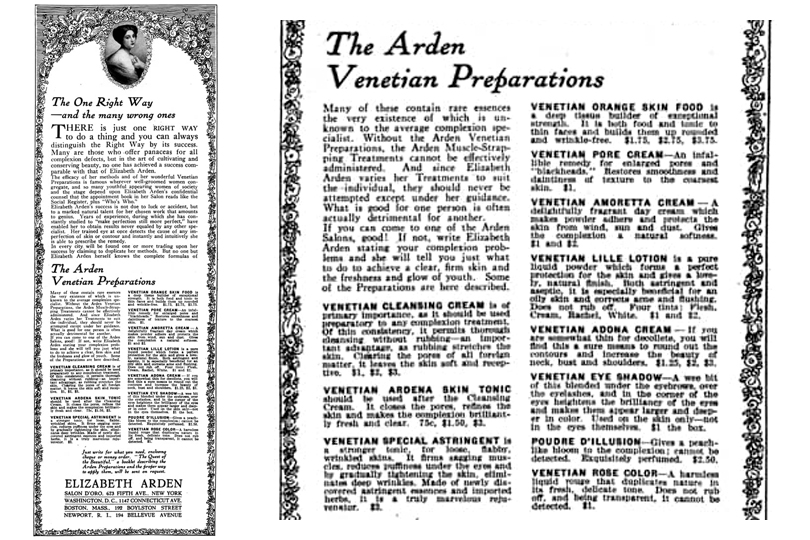
The earliest evidence of a commercial product called ‘eye shadow’ dates back to the 1910s in North America. Elizabeth Arden – we’re talking about the woman now, not the brand – started her brand in New York in 1910 with a salon on New York’s Fifth Avenue. Her company grew at an impressive rate, partially thanks to eyeshadow, and over time she became one of the wealthiest women in the world.
In 1912, Miss Arden visited beauty salons in Paris to study products and techniques, and stimulated a greater interest in makeup on her return home. She became the first to introduce, popularize and heavily monetize eye makeup to American women when she introduced a brown Venetian Eye Shadow powder in 1914. In the years that followed, the Elizabeth Arden eyeshadow was advertised in North American newspapers as part of the Arden Venetian Preparations range of cosmetics, a first for the beauty staple.
Elizabeth Arden’s eyeshadow was later renamed Venetian Eye Sha do in 1922, but it was an important part of the beginning of a makeup empire. The success of the product was followed by the development of lip cosmetics and a wider range of face powders and rouges, and eventually the company grew into today’s skincare, cosmetics and fragrance brand.
Elizabeth Arden started a trend, and beauty brands like Maybelline, Helena Rubinstein Incorporated and Max Factor followed suit, taking the beauty industry by storm.
The post-World War II era saw the rise of new cosmetic brands and innovations. In the 1960s, vibrant eyeshadow colours became a symbol of the counterculture movement, and the trend continued into the 1970s, when glittery eyeshadow looks became mainstream. The 1980s saw the introduction of bold, intense colours (yes…like bright blue) being worn as eyeshadow, while the 1990s saw a number of eyeshadow trends, including frosted eyeshadow looks, lots of pastels, and the smudged-out, lived-in, dark-coloured eyeshadow that was a big part of the grunge movement.
Today, eyeshadow is available in an unprecedented variety of colours, textures and formulations from an endless number of independent and corporate makeup brands, and there’s no end in sight. The beauty industry continues to evolve and release new products, embracing diversity, offering even more products that cater to all skin tones and preferences. Makeup, including eyeshadow, is being promoted to everyone of every race, gender and class, and eyeshadow has in many ways turned into whatever anyone wants it to be. Plus, innovations such as long-lasting and waterproof formulas have made eyeshadow more versatile and loved than ever.
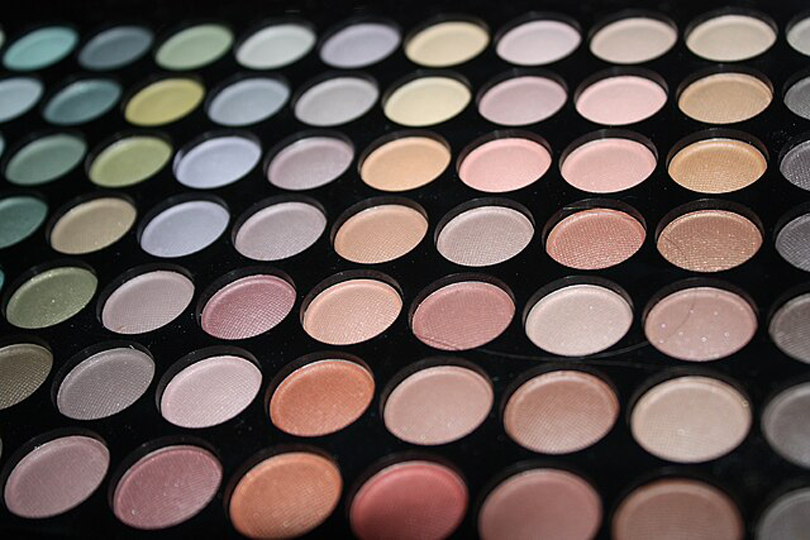
And then there’s social media. The rise of social media and beauty influencers has also played a significant role in popularizing new eyeshadow trends, with changes happening at a lightning pace. From smoky eyes to intricate cut-crease designs, eyeshadow continues to be a powerful tool for self-expression and creativity. Looking for the next trend? Hop on Instagram or TikTok to find the latest eyeshadow trend (or hack) of the week.
It’s a long way from where it began, but the history of eyeshadow is a testament to its enduring appeal and cultural significance. From the ancient world to modern-day beauty trends, eyeshadow has evolved while maintaining its fundamental purpose: to enhance and transform the eyes. As cosmetic technology continues to advance, the future of eyeshadow looks promising, with endless possibilities for innovation and creativity.
![]()
Want more? You can read other stories from our The Story Of series right here.

